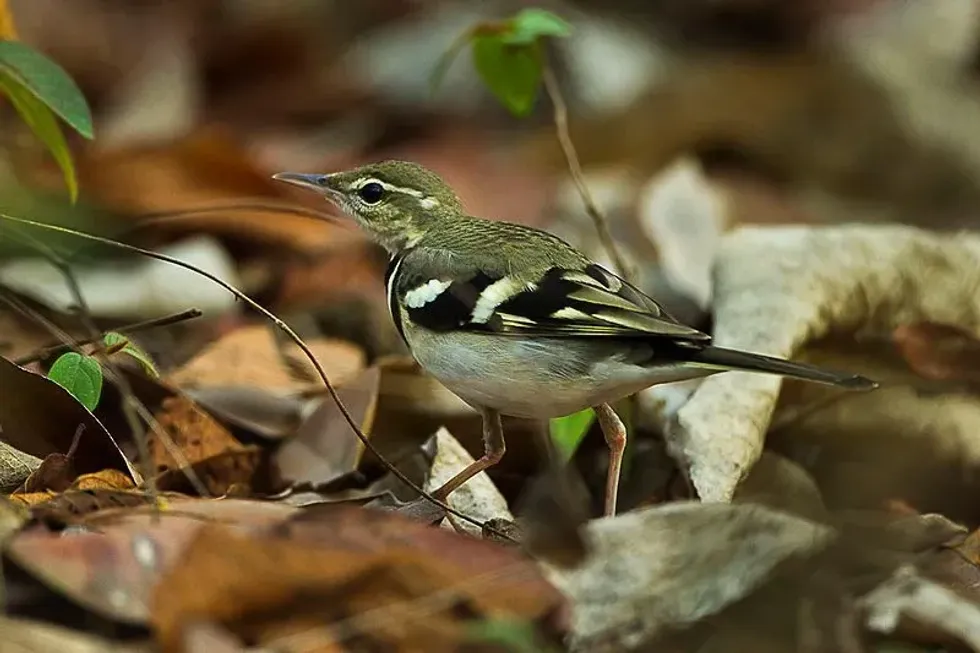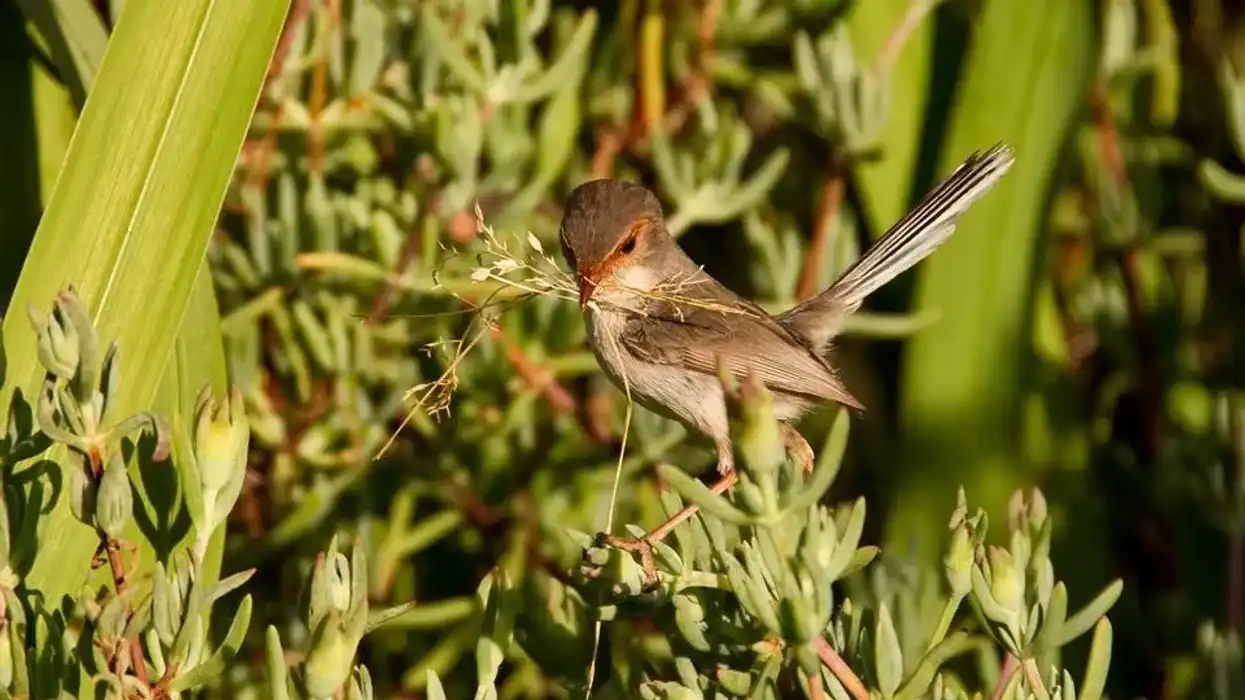The forest wagtail (Dendronanthus indicus) is a forest species of the wagtail family. These birds are migratory, migrating away from the temperate parts of Asia to other countries in Asia, and are found mainly in India, Sri Lanka, and Indonesia.
Their genus and class are Dendronanthus and Aves, respectively. They have an olive-brown and white body with a dark brown band across it, found mainly wintering across cold temperate areas. They form a monogamous pair for breeding.
Read on for more information and a description of the forest wagtail (Dendronanthus indicus). Learn about its names, breast band, underparts, length, and much more!
You can also check out exciting information about the palm warbler facts and the red-backed shrike facts.
Forest Wagtail Interesting Facts
What type of animal is a forest wagtail?
The forest wagtail (Dendronanthus indicus) is a bird species from east Asia. They are medium-sized passerine birds with long claws on their feet.
What class of animal does a forest wagtail belong to?
The forest wagtail (Dendronanthus indicus) belongs to the class of Aves and the Motacillidae family.
How many forest wagtails are there in the world?
At present, the exact number of forest wagtails present across the world is not known. However, it can be ascertained that there are plenty of these birds found across their range of distribution.
Where does a forest wagtail live?
The forest wagtail (Dendronanthus indicus) is endemic to East Asia. Their distribution ranges from the temperate region of Siberia, spreading over Korea, northern China, India, Indonesia, Sri Lanka, the Andaman Islands, the Maldives, and Australia. These wagtails migrate from the temperate parts to the tropical and sub-tropical regions to escape from the cold and harsh winters.
What is a forest wagtail's habitat?
A forest wagtail (Dendronanthus indicus) habitat comprises a variety of areas like grassy plains, open woodlands, forest clearings, forest litter, and shaded shrubland. The forest wagtail (Dendronanthus indicus) mostly prefers living atop trees but sometimes comes down to the ground to forage on different insects in the forest litter.
They can also live in high altitudes in temperate areas, near open woodlands, mangroves, and on mudflats. They are found in many parts of the world.
Who do forest wagtails live with?
The forest wagtail (Dendronanthus indicus) is comfortable living a solitary life, in a pair, or in small groups.
How long does a forest wagtail live?
The average lifespan of a forest wagtail (Dendronanthus indicus) is similar to other wagtail species, which ranges between 9-11 years in the wild.
How do they reproduce?
To attract a female, the male takes a flight over its territory, singing a metallic 'pink pink' mating song. The breeding partners form a monogamous pair for life.
The breeding season ranges from April to June for the forest wagtail (Dendronanthus indicus). While both the male and the female search for nest-building materials, the nest is solely built by the female.
The nest is built atop tall trees 19.7-23 ft (6-7 m) above the ground and is shielded well with mosses and leaves, camouflaging and protecting it. After mating, the female lays four to five eggs and incubates them using her breast and underparts to keep them warm for 12-13 days.
The male partner brings in food for the female and feeds her during this period. After the eggs hatch, both parents look after the young for 10-12 days before they take their first flight.
What is their conservation status?
At present, the forest wagtail (Dendronanthus indicus) is listed as a world species of Least Concern status in the IUCN Red Book. This bird species is relatively free from any survival threats at present. However, proper scientific research and conservation efforts should be attempted from the early stages to prevent population decline.
Forest Wagtail Fun Facts
What do forest wagtails look like?

The forest wagtail (Dendronanthus indicus) is a medium-length bird with an olive-brown crown and back. Their wings have an alternating pattern of white and black with two yellow patches. The underparts are mostly white in color with two black breast bands.
A white supercilium is seen around their dark brown eyes. The upper side of the bill is dark grayish-brown in color, while the lower side is pale pink. Their legs are pale pink with hind claws on their feet.
How cute are they?
The forest wagtail's (Dendronanthus indicus) appearance is charming and attractive because of the beautiful contrasting black and white stripes and dark patches on its body. The slender body with a short tail and puffed-up breast give them a very adorable look.
How do they communicate?
The forest wagtail (Dendronanthus indicus) of the Dendronanthus genus has a habit of giving out single note calls, which often sound like 'pink pink.' It is a disyllabic tune repeated four to five times, making 'dzi-chu dzi-chu' noises.
The males communicate verbally while displaying their flight to attract females for mating. They often sing a lilting song with short pauses.
How big is a forest wagtail?
The average length of the forest wagtail (Dendronanthus indicus) is 7.1 in (18 cm). These birds are three times bigger than an Indian sparrow, both of which look quite similar in photos.
How fast can a forest wagtail fly?
There is no exact estimate of the flight speed of the forest wagtail (Dendronanthus indicus). However, it can be ascertained that they fly very swiftly, covering great distances across countries. The bird can also reach great heights between 26.2-32.8 ft (8-10 m).
How much does a forest wagtail weigh?
The average weight of a forest wagtail (Dendronanthus indicus) falls between 0.5-0.6 oz (14-17 g).
What are the male and female names of the species?
There are no sex-specific names given to the forest wagtail.
What would you call a baby forest wagtail?
A baby forest wagtail (Dendronanthus indicus) is called a chick.
What do they eat?
This bird species has an omnivorous eating habit, mostly feeding atop trees. The forest wagtail species feeds on a variety of small fauna like grasshoppers, butterflies, cicadas, Hymenoptera, beetles, spiders, mollusks, and worms.
Are they poisonous?
The forest wagtail (Dendronanthus indicus) has not posed any threat to humans anywhere in the world. There is no evidence of this wagtail bird species being poisonous to humans or other animals in the world. However, they are efficient hunters of their prey.
Would they make a good pet?
It is not advisable to keep a forest wagtail (Dendronanthus indicus) as a pet. These migratory wagtails are accustomed to flying freely across countries, so caging them at home is undesirable.
Did you know...
When a solitary or forest wagtail (Dendronanthus indicus) breeding pair feels disturbed, they move up into the tree canopy to maintain peace.
A forest wagtail (Dendronanthus indicus) can walk and run to catch its prey on the ground, and it can catch prey on the wing.
The forest wagtail differs from related wagtails as it swings its body from side to side, while other wagtails of the Motacillae family wag their tails up and down.
In India, this bird genus is found mainly breeding in Assam and the western-coastal areas.
The Japanese have named the forest wagtail (Dendronanthus indicus) 'Jokofury-sekerei,' a Japanese term describing their side-to-side swinging habit.
Other wagtail bird species of the world have names such as white wagtails and pied wagtails.
The population range of the forest wagtail (Dendronanthus indicus) is increasing in India over the other wagtails of the Motacillae family.
Are forest wagtails migratory?
The forest wagtail (Dendronanthus indicus) is one of the famous birds of the world with its migratory range extending from Siberia, northern China, Korea, India, Sri Lanka, Thailand, India, Indonesia, East Asia, up to Australia. They like wintering across the temperate parts of Siberia, Asia, and northern China.
World migration among these birds is a consequence of their inability to withstand the freezing winter temperatures of the north up to the month of March.
Here at Kidadl, we have carefully created lots of interesting family-friendly animal facts for everyone to discover! Learn about some other birds of the world from our flycatcher interesting facts and whiskered treeswift interesting facts pages.
You can even occupy yourself at home by coloring in one of our free printable wagtail coloring pages.
Main image by Francesco Veronesi.
Second image by Jason Thompson.









